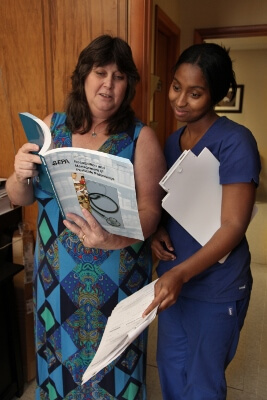MCN's Environmental and Occupational Health Program Initiatives
Primary Care and Environmental and Worker Health
 MCN works with front-line providers to integrate a focus on environmental and occupational health into primary care. Our projects strengthen the quality of care and meet the unique healthcare needs of the migrant population. MCN recognizes that the majority of primary care clinicians, including those caring for migrants and immigrant workers, generally do not bring an environmental and occupational health perspective to the care they provide. MCN focuses on feasible, simple changes in clinical practices to improve the recognition and management of occupational exposures and injuries.
MCN works with front-line providers to integrate a focus on environmental and occupational health into primary care. Our projects strengthen the quality of care and meet the unique healthcare needs of the migrant population. MCN recognizes that the majority of primary care clinicians, including those caring for migrants and immigrant workers, generally do not bring an environmental and occupational health perspective to the care they provide. MCN focuses on feasible, simple changes in clinical practices to improve the recognition and management of occupational exposures and injuries.
MCN partners with community health centers across the US and Puerto Rico to establish Centers of Excellence in Environmental and Occupational Health. These partnerships include on-site clinical training, the provision of resources and technical assistance, and peer-to-peer networking between front-line providers and occupational and environmental medicine specialists.
MCN also conducts research to explore barriers to occupational health in primary care.
Download a description of MCN's Workers and Health Program
**Many of MCN’s EOH efforts are supported through cooperative agreements with the US Environmental Protection Agency as part of their National Strategies for Health Care Providers: Pesticide Initiative. The conclusions and opinions expressed herein are those of MCN and do not necessarily reflect the positions and policies of the U.S. EPA.
Photos by Earl Dotter